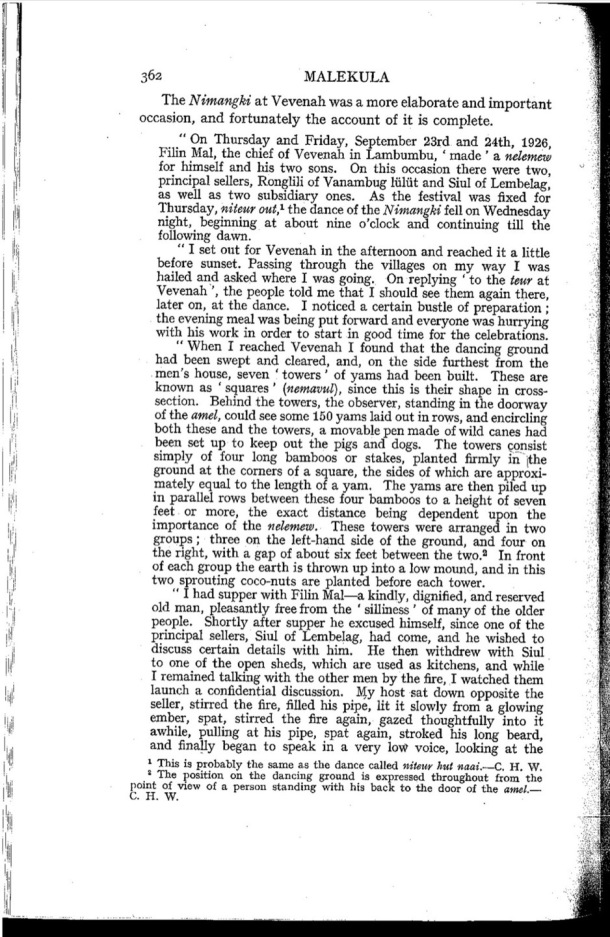|
|  [Note: this transcription was produced by an automatic OCR engine]
la
ll
ll
ll‘
1“,
i l
ll
~
,.
,l
1,.
ll
J‘
l:,‘
I1“
1, {
;‘l
if
ll‘
;~i
, ll
l ll
l l.
l Fl
it
all
362 MALEKULA
The N imangki at Vevenah was a more elaborate and important
occasion, and fortunately the account of it is complete.
" On Thursday and Friday, September 23rd and 24th, 1926,
Filin Mal, the chief of Vevenah in Lamhurnbu, ‘ made ’ a nelemeuz
for himself and his two sons. On this occasion there were two,
principal sellers, Ronglili of Vanarnbug liiliit and Siul of Lembelag,
as well as two subsidiary ones. As the festival was ï¬Åxed for
Thursday, niteur out,‘ the dance of the Nimangki fell on Wednesday
night, beginning at about nine o'clock and continuing till the
following dawn.
“ I set out for Vevenah in the afternoon and reached it a little
belore sunset. Passing through the villages on my way I was
hailed and asked where I was going, On replying ' to the tow at
Vevenah ', the people told me that I should see them again there,
later on, at the dance. I noticed a certain bustle of preparation ;
the evening meal was being put forward and everyone was hurrying
with his work in order to start in good time for the celebrations.
" When I reached Vevenah I found that the dancing ground
had been swept and cleared, and, on the side furthest from the
men's house, seven ‘towers’ of yarns had been built. These are
known as ‘squares’ (nemavul), since this is their shape in cross-
scction. Behind the towers, the observer, standing in the doorway
of the aml, could see some 150 yams laid out in rows, and encircling
both these and the towers, a movable pen made of wild canes had
been set up to keep out the pigs and dogs. The towers consist
simply of four long bamboos or stakes, planted ï¬Årmly in the
ground at the comers of a s uare, the sides of which are approxi-
mately equal to the length 0% a yam. The yams are then piled up
in parallel rows between these iour bamboos to a. height of seven
feet or more, the exact distance being dependent upon the
importance oi the nalmwu/. These towers were arranged in two
groups; three on the lelt-hand side of the ground, and four on
the right, with a gap of about six feet between the two.’ In front
of each group the earth is thrown up into a low mound, and in this
two sprouting coco-nuts are planted before each tower.
" I had supper with Filin Mal—a kindly, digniï¬Åed, and reserved
old man, pleasantly free from the ‘silliness’ of many of the older
people. Shortly after supper ho excused himself, since one of the
principal sellers, Siul of Lembelag, had come, and he wished to
discuss certain details with him. He then withdrew with Siul
to one oi the open sheds, which are used as kitchens, and while
I remained talking with the other men by the ï¬Åre, I watched them
launch a conï¬Ådential discussion. My host sat down opposite the
seller, stirred the ï¬Åre, ï¬Ålled his pipe, lit it slowly from a glowing
ember, spat, stirred the ï¬Åre again, gazed thoughtfully into it
awhile, pulling at his pipe, spat again, stroked his long beard,
and ï¬Ånally began to speak in a very low voice, looking at the
I This is probably the same as the dance called Mikur l1ul1 The positimr on the dancing gxound is expressed throughout from the
Belg tgvview oi a person standing with his back to the door of the lime].-
.;.~.. ,
1
|